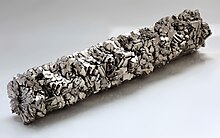Titanium ore
 |
||||||||||||||||||||||||||||||||||||||
| General properties | ||||||||||||||||||||||||||||||||||||||
|---|---|---|---|---|---|---|---|---|---|---|---|---|---|---|---|---|---|---|---|---|---|---|---|---|---|---|---|---|---|---|---|---|---|---|---|---|---|---|
| Pronunciation |
/tɪˈteɪniəm/ or /taɪˈteɪniəm/ tih-TAY-nee-əm or ty-TAY-nee-əm |
|||||||||||||||||||||||||||||||||||||
| Appearance | silvery grey-white metallic | |||||||||||||||||||||||||||||||||||||
| Standard atomic weight (Ar, std) | 47.867(1) | |||||||||||||||||||||||||||||||||||||
| Titanium in the periodic table | ||||||||||||||||||||||||||||||||||||||
|
||||||||||||||||||||||||||||||||||||||
| Atomic number (Z) | 22 | |||||||||||||||||||||||||||||||||||||
| Group, period | group 4, period 4 | |||||||||||||||||||||||||||||||||||||
| Block | d-block | |||||||||||||||||||||||||||||||||||||
| Element category | transition metal | |||||||||||||||||||||||||||||||||||||
| Electron configuration | [Ar] 3d2 4s2 | |||||||||||||||||||||||||||||||||||||
|
Electrons per shell
|
2, 8, 10, 2 | |||||||||||||||||||||||||||||||||||||
| Physical properties | ||||||||||||||||||||||||||||||||||||||
| Phase (at STP) | solid | |||||||||||||||||||||||||||||||||||||
| Melting point | 1941 K (1668 °C, 3034 °F) | |||||||||||||||||||||||||||||||||||||
| Boiling point | 3560 K (3287 °C, 5949 °F) | |||||||||||||||||||||||||||||||||||||
| Density (near r.t.) | 4.506 g/cm3 | |||||||||||||||||||||||||||||||||||||
| when liquid (at m.p.) | 4.11 g/cm3 | |||||||||||||||||||||||||||||||||||||
| Heat of fusion | 14.15 kJ/mol | |||||||||||||||||||||||||||||||||||||
| Heat of vaporization | 425 kJ/mol | |||||||||||||||||||||||||||||||||||||
| Molar heat capacity | 25.060 J/(mol·K) | |||||||||||||||||||||||||||||||||||||
Vapor pressure
|
||||||||||||||||||||||||||||||||||||||
| Atomic properties | ||||||||||||||||||||||||||||||||||||||
| Oxidation states | 4, 3, 2, 1, −1, −2 (an amphoteric oxide) | |||||||||||||||||||||||||||||||||||||
| Electronegativity | Pauling scale: 1.54 | |||||||||||||||||||||||||||||||||||||
| Ionization energies |
|
|||||||||||||||||||||||||||||||||||||
| Atomic radius | empirical: 147 pm | |||||||||||||||||||||||||||||||||||||
| Covalent radius | 160±8 pm | |||||||||||||||||||||||||||||||||||||
|
||||||||||||||||||||||||||||||||||||||
| Miscellanea | ||||||||||||||||||||||||||||||||||||||
| Crystal structure | hexagonal close-packed (hcp) | |||||||||||||||||||||||||||||||||||||
| Speed of sound thin rod | 5090 m/s (at r.t.) | |||||||||||||||||||||||||||||||||||||
| Thermal expansion | 8.6 µm/(m·K) (at 25 °C) | |||||||||||||||||||||||||||||||||||||
| Thermal conductivity | 21.9 W/(m·K) | |||||||||||||||||||||||||||||||||||||
| Electrical resistivity | 420 nΩ·m (at 20 °C) | |||||||||||||||||||||||||||||||||||||
| Magnetic ordering | paramagnetic | |||||||||||||||||||||||||||||||||||||
| Magnetic susceptibility | +153.0·10−6 cm3/mol (293 K) | |||||||||||||||||||||||||||||||||||||
| Young's modulus | 116 GPa | |||||||||||||||||||||||||||||||||||||
| Shear modulus | 44 GPa | |||||||||||||||||||||||||||||||||||||
| Bulk modulus | 110 GPa | |||||||||||||||||||||||||||||||||||||
| Poisson ratio | 0.32 | |||||||||||||||||||||||||||||||||||||
| Mohs hardness | 6.0 | |||||||||||||||||||||||||||||||||||||
| Vickers hardness | 830–3420 MPa | |||||||||||||||||||||||||||||||||||||
| Brinell hardness | 716–2770 MPa | |||||||||||||||||||||||||||||||||||||
| CAS Number | 7440-32-6 | |||||||||||||||||||||||||||||||||||||
| History | ||||||||||||||||||||||||||||||||||||||
| Discovery | William Gregor (1791) | |||||||||||||||||||||||||||||||||||||
| First isolation | Jöns Jakob Berzelius (1825) | |||||||||||||||||||||||||||||||||||||
| Named by | Martin Heinrich Klaproth (1795) | |||||||||||||||||||||||||||||||||||||
| Main isotopes of titanium | ||||||||||||||||||||||||||||||||||||||
|
||||||||||||||||||||||||||||||||||||||
|
|
Titanium is a chemical element with symbol Ti and atomic number 22. It is a lustrous transition metal with a silver color, low density, and high strength. Titanium is resistant to corrosion in sea water, aqua regia, and chlorine.
Titanium was discovered in Cornwall, Great Britain, by William Gregor in 1791, and was named by Martin Heinrich Klaproth for the Titans of Greek mythology. The element occurs within a number of mineral deposits, principally rutile and ilmenite, which are widely distributed in the Earth's crust and lithosphere, and it is found in almost all living things, water bodies, rocks, and soils. The metal is extracted from its principal mineral ores by the Kroll and Hunter processes. The most common compound, titanium dioxide, is a popular and is used in the manufacture of white pigments. Other compounds include titanium tetrachloride (TiCl4), a component of smoke screens and catalysts; and titanium trichloride (TiCl3), which is used as a catalyst in the production of polypropylene.
...
Wikipedia

